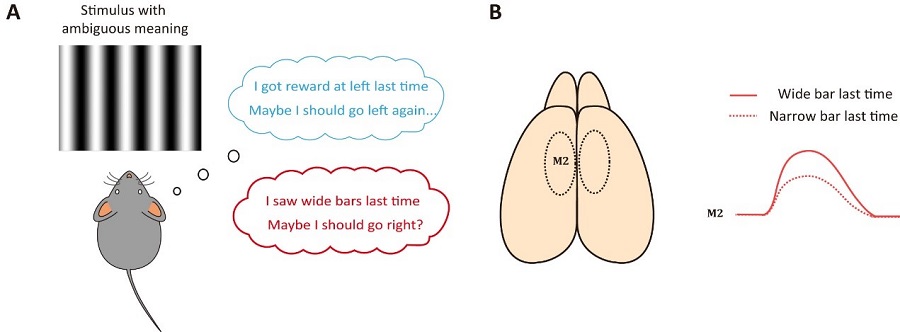Time:2020-07-01
A recent study published in eLife reveals that the secondary motor cortex contributes to adaptive action selection during flexible visual categorization. This work was performed by researchers in Dr. YAO Haishan’s Lab at the Institute of Neuroscience, Center for Excellence in Brain Science and Intelligence Technology of Chinese Academy of Sciences, State Key Laboratory of Neuroscience.
Grouping sensory stimuli and events into functional categories is a fundamental cognitive ability of humans and other animals. In a dynamic environment, animals are often faced with the challenge to adjust their behaviors according to changes in the relationship between stimulus, response and outcome. In the case of stimulus categorization, a change in the categorical boundary requires a remapping of stimulus-action association. Such behavioral flexibility is important for the survival of animals.
Previous studies have found neural correlates of flexible stimulus categorization in monkey pre-supplementary motor area and frontal eye field. As a homolog of primate premotor cortex, supplementary motor area and frontal eye field, rodent secondary motor cortex (M2) was found to exhibit choice-related activity and encode information about trial history. However, it remains to be investigated whether M2 plays a causal role in flexible stimulus categorization, and whether the choice- and history-related signals in M2 are modulated by task demand.
The authors trained freely-moving mice to categorize visual stimuli as low or high spatial frequencies (SFs) by choosing the left or right choice port. Within a session, the categorical boundary shifted between a lower and a higher SF, and a shift in boundary required the mouse to reverse its choice for the reversing stimulus, whose SF lied between the two boundaries. The authors built a computational model with a dynamic decision criterion to examine the behavioral strategies of mice. They found that sensory history was important for adaptive action selection after the switch of boundary. Using chemogenetic manipulation, the authors found that bilateral inactivation of M2 impaired adaptive action selection by reducing the mice’s ability to update decision criterion according to sensory history. By recording from M2 in behaving mice, the authors further showed that M2 activity carried more information about upcoming choice and previous sensory stimuli when the sensorimotor association needed to be flexibly adjusted. In summary, Dr. YAO’s lab demonstrates that M2 plays an important role in sensory-history-dependent adaptive choice behavior during flexible stimulus categorization.
This work entitled “Control of adaptive action selection by secondary motor cortex during flexible visual categorization” was published online in eLife on June 24, 2020. This work was completed by WANG Tianyi, under the supervision of Dr. YAO Haishan, with help from LIU Jing. This work was supported by grants from National Natural Science Foundation of China, Chinese Academy of Sciences, and Shanghai Municipal Government.

Secondary motor cortex contributes to adaptive action selection.(Image by CEBSIT)
Figure legend: A. During visual categorization, mice were required to compare the current stimulus to their internal decision criterion, and report their choices by going to the left or right choice port. After a shift in categorization boundary, the mouse should reverse its choice for the reversing stimulus. When the current sensory evidence was ambiguous, mice could solve the task by relying on trial history, which included history of past stimuli and choice outcome. B. Schematic showing that M2 neurons exhibit preference for stimulus in last trial.
AUTHOR CONTACT: YAO Haishan , Ph.D.
Institute of Neuroscience, Center for Excellence in Brain Science and Intelligence Technology of the Chinese Academy of Sciences
Email:haishanyao@ion.ac.cn
 附件下载:
附件下载: